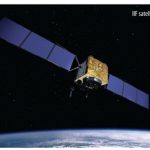
High-precision users of GNSS are used to solving for carrier phase integer ambiguities, but the recent publication of a GPS technical document has fixed a different kind of phase ambiguity — a linguistic one
High-precision users of GNSS are used to solving for carrier phase integer ambiguities, but the recent publication of a GPS technical document has fixed a different kind of phase ambiguity — a linguistic one: the difference between “shall” and “can.”
At issue were details of the new “flex power” capability being added for military GPS signals, which enables operators of the system to increase the signal strength of the military P(Y) and M-code signals if needed by Department of Defense (DoD) and allied GPS users.
The devil, as the old adage goes, is in the details. And, when it came to the question of the stability of the new civil L2 (L2C) signal, a lot of people are reading the fine print in the Interface Specification for GPS version 200E (IS-GPS-200E) released by the U.S. Air Force on August 13.
Fixed phase relationships are important to precise applications such as surveying, construction, and agriculture, which represent approximately 10 percent of the GNSS user base, according to Charles Trimble, founder of GNSS manufacturer Trimble Navigation and a member of National Space-Based Positioning, Navigation, and Timing (PNT) Advisory Board.
When the L2C signal was first proposed, its definition called for a fixed phase. About four years ago, however, a test for flex power discovered that phase shifts occurred on L2C as power levels changed on the military signals, causing considerable “consternation” among users, according to Trimble.
Further complicating the system was the fact that users of the so-called “semi-codeless” positioning techniques, which exploit the carrier phase on the P-code even when encrypted (Y-code), were being asked to migrate away from P(Y) and onto L2C.
A September 23, 2008, Federal Register notice said that the U.S. government would only guarantee signal characteristics needed for semi-codeless GPS applications until December 31, 2020.
In the meantime, the Office of Assistant Secretary of Defense/Networks and Information Integration (ASD/NII) announced that GPS modernization would be governed by signal specifications — with a reference to the pertinent DoD website. When users consulted that website, they encountered a document in which the original reference to “fixed phase relationship” going back to 1986 had been changed from “shall” to “can.”
This prompted uncertainty as to the utility of the L2C signal for precision applications, according to Trimble, who at a May 19, 2009, meeting of the advisory board urged that this concern be addressed. He proposed that the Air Force should either returning the “shall” to the signal specification or add a covering statement that the U.S. government intended for the modernizing GPS system to provide at least equal capabilities as the legacy system.
The issue moved to a public GPS Interface Control Working Group (ICWG), a group chartered by the GPS Wing (formerly GPS Joint Program Office) comprised of Air Force representatives, contractors (such as the Aerospace Corporation), other government agencies, and non-government organizations that help define, develop, implement, and maintain the GPS interfaces.
In the words of its 2006 charter, “The ICWG shall serve as a forum to develop and provide interface requirements, as well as focus on interface detail definition and issues,” especially to “address and resolve interface issues and problems that cannot be resolved through associate contractor daily working procedures.”
The L2C/flex power issue drew participation from federal agencies, such as NASA, the departments of commerce and transportation, as well as the U.S. GPS Industry Council, manufacturers, professional users, and private consultants. After the effects of flex power on phase relationships were discovered, the Air Force subsequently studied the matter and identified four ways to eliminate the phase shift caused by flex power.
Over the next couple of years, the ICWG worked the issue, finally reaching consensus on the text that went into the recent revision of the GPS specification. Revised sections define a single, stable baseline phase relationship for L2C.
Under the terms of the 2008 Federal Register notice and a related 2009 notification letter from Gen. C. Robert Kehler, Air Force Space Command, on the subject, signal stability to support semi-codeless techniques will be maintained at least through the 2020 time frame. (The 2020 date assumes that at least 24 GPS satellites on orbit transmitting L2C and L5 signals.)
After that, if flex power is used at L2 in a way that causes the phase relationship to change, the users will be notified via a new message bit in the L2C signal. L2C-capable equipment can then use that bit to adjust its measurements accordingly and maintain reliable, high-accuracy positioning.
Among the most significant changes from IS-GPS-200D to 200E is language in sections 3.3.1.5.1 (Phase Quadrature) and 3.3.1.5.3 (Phase Continuity). The phase quadrature section defines the phase relationship between the carriers of the L2C and P(Y) signals.
As mentioned, this relationship was previously not fixed — it could vary among multiple states depending on whether and how the “flex power” capability planned for new generations of satellites was in use. The new language that has been implemented eliminates that ambiguity.
Section 3.3.1.5.1 in 200E now states: “For Block IIR-M, IIF, and subsequent blocks of SVs, the two L2 carrier components shall be either in phase quadrature or in the same phase (within ±100 milliradians). . . The resultant composite transmitted signal phases will vary as a function of the binary state of the modulating signals as well as the signal power ratio and phase quadrature relationship.”
The section goes on to explain how user equipment will be notified of the current phase relationship of the two L2 carrier components — L2C and L2P(Y).
The language in the section on phase continuity —3.3.1.5.3 — is similarly clear: “While the satellite is broadcasting standard C/A, P(Y), and L2C codes with data that indicates that C/A, P(Y), and L2C signal health (respectively) is OK, there will not be any commanded operation causing an intentional phase discontinuity.”
The release of IS-GPS-200E — now in force — thus appears to be a positive step forward for members of the high-precision positioning community, assuring them that they can expect full continuity of service as they migrate from semi-codeless technology to L2C, even in the face of flex power. Prior to 200E, this was not entirely clear, but now it is officially documented.
The relevant technical specifications and related documents can be found on a new section of the website developed by the National Space-Based Positioning, Navigation, and Timing Coordination Office and hosted by the U.S. Coast Guard Navigation Center <http://www.gps.gov/technical>.




